You are here: Home | Economy | Featured | Humanitarian | News | How floods introduced new method of farming in Warrap
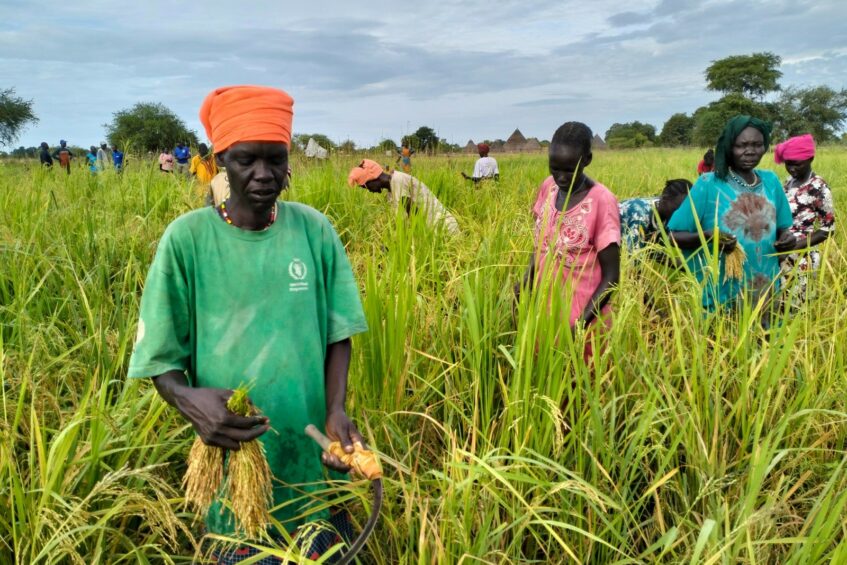
Farmers harvest rice in Warrap State. (Photo: Moyo JACOB/Eye Radio).
In Warrap State, where large settlements have been inundated by flashfloods and other stricken by dry spells in recent years, farmers abandon staple crops and turn to rice cultivation in a bid to adapt to the impact of climate change.
The food security situation has deteriorated in the state, not only due to the climate shocks but other factors including localized conflict-driven displacement, says the UN World Food Program.
Warrap has six counties with an estimated population of 1,222,397 people and covers an area of 33,962 square kilometers.
Since 2019, South Sudan’s northern regions, including Warrap, have been adversely affected by flooding that had submerged farmlands and wiped livestock – leading to loss of livelihood and a prevailing food security situation.
The floods and droughts factors, which manifest the reality of climate change, have forced the state farmers to shift crops from the staple sorghum to rice.
This year, WFP Field Office in Kuajok has supported 60% of the state population – approximately about 700,233 beneficiaries including 16,000 Sudan returnees.
The civilians benefitted under different relief programs including the delivery of 19,889 tons of assorted food commodities and 7.71 million US dollars in direct cash transfer.
The agency is also serving 206,056 recipients under GFD+ (Lean Season Response) with 11,219 metric tons of assorted food commodities and 5.5 m The farmers in Tura into a new normal by planting crops that are resist.
WFP and partners are supporting Lean Season Response recipients to participate in different activities that can add value to their livelihood and food security Status.
The activities funded by the agency are crops cultivation, vegetable gardening, training in bread making, construction of beneficiary waiting shades and rehabilitation of school kitchen.
Besides, WFP, partners, and local communities are adopting different mitigation measures to combat the impact of climate change.
James Majong Deng is one of the local farmers and a member of a group of farmers on a 31 feddan’s rice garden in Turalei town.
“We are benefiting from this rice for our consumption through the help of WFP. Before the organization came, we used to farm sorghum and when we do that, the flooding comes and destroys it, giving us losses,” he told Eye Radio.
Majong said he is optimistic that with the current local production, there will be a reduced importation of rice from Juba as communities will buy the locally produced yield.
Majong also voiced confidence in expanding the rice farm in the near future to increase resilience within the area through agriculture.
“The organization came with an idea and told us that when you plant rice in the flood-affected lands, it will do well. We told them to bring, and we try. We tried it with one feddan and we were advised then to try with two feddans, we did, and we harvested ten bags of rice.”
“Now, our children are not suffering. We kept on doing slowly, slowly and we made 18 bags in Malou. We then cultivated 31 feddans in Nyinitorok in a place called Mapir Amal, where we are now standing.”
Mr Majong further encourages the neighboring communities and the country people to adopt diversification of farm production to withstand the effects of climate changes.
“We have a large land and I believe after three years; we would cultivate this whole bush. I believe World Food Program will help us with equipment so we can work.”
“I will say, the Bomas that have not cultivated rice, please do so like we have done, and I would urge all the people of Warrap and other areas like Bor and Aweil to do the same and am sure, we will have enough rice in South Sudan. We will eat it and sell some to pay our children in school”.
Warrap is among other States in the country that has seasonally been hit by floods eventually failing crops and subjecting people into famine.
The UN Food Agency introduced new crops including rice to help the flood-affected areas overcome the effects of climate change.
The support which includes the technical skills to farm, helps the communities to make good use of the floods to enjoy harvests by planting rice which is resistant to floods.
Another farmer is Angong Deng, who has joined the society of local farmers in the cultivation of rice in Turalei.
She says, their emphasis has previously been on sorghum which has become vulnerable to climatic shocks and that, they have now been introduced to rice which serves as an alternative to overcoming adverse weather conditions.
“We are cultivating rice but before, we used to cultivate only sorghum, we didn’t know about rice farming, but we thank God, humanitarian agencies (WFP) came and brought for us seeds,” she said.
Ms. Deng stated: “We used to farm sorghum then sorghum does not do well with this weather condition, so, we planted rice and rice is doing well, it is now helping us so much.”
She revealed how the agency has been instrumental in transforming their lives.
“WFP used to support us with money and tells us that, do this work, it will help you and they gave us money to help us.”
“That time, we didn’t have any money to help us put our children in schools and access medication. The climatic changes are now good with us but that time, it was really hindering us.”
Angong said she is living with 15 members of her family – all depending on the produce she gets from the rice farm.
“I have 15 people at home. They are living with me at home, and I take care of their feeding. I have the children of my brother who fled the conflict in Khartoum (Sudan), they are living with me.”
“This rice is fine with us and we are happy for that. Now, we process it locally and when we process it with local machines, it gets broken and when we take to market, people don’t buy like the imported rice.”
Angong called on WFP, the government and other organizations and the government to support the farmers with processing equipment to help us avoid incurring losses.
On his part, Stephen Moseray, head of WFP Field Office in Kuajok, said the introduction of rice farming is an opportunity to improve on the food security status of the household and the State.
“The whole idea is to use the floods which have become a problem, as an opportunity to improve on the food security status and household food security status of the State and eventually hopefully in the rest of the country,” he said.
“Livelihood activities have been going on for a number of years and WFP has been in South Sudan as you know for a number of years, but the impact of climate change has been felt more severely in just in the recent past.”
“The livelihood activities have been continuing, have been going on even before the introduction of the rice farm. This is a new crop that was introduced a couple of years ago and as you can see, it is striving very well.”
He is optimistic that with the introduction of rice in the area and building the capacity of the local farmers, agricultural activities will continue to grow in the State.
“Rice has been around for I don’t know, hundreds of years maybe but in this part of the country, it is a new crop in a sense that, before the introduction of this, people were not used to consuming rice.”
Mr Moseray, however, warned that the agency will not be there forever to support the farmers with equipment and seeds, adding that they should be prepared to be sustainable.
“Of course, at some point, WFP will have to move on, we will not be here forever.”
“But the hope is that, with the introduction of such crops, providing the technical expertise through the partners as well, that the communities will be able to learn how to utilize these skills to continue with this project.”
“But for the next few years, at least I think WFP is still around to strengthen what we have started.”
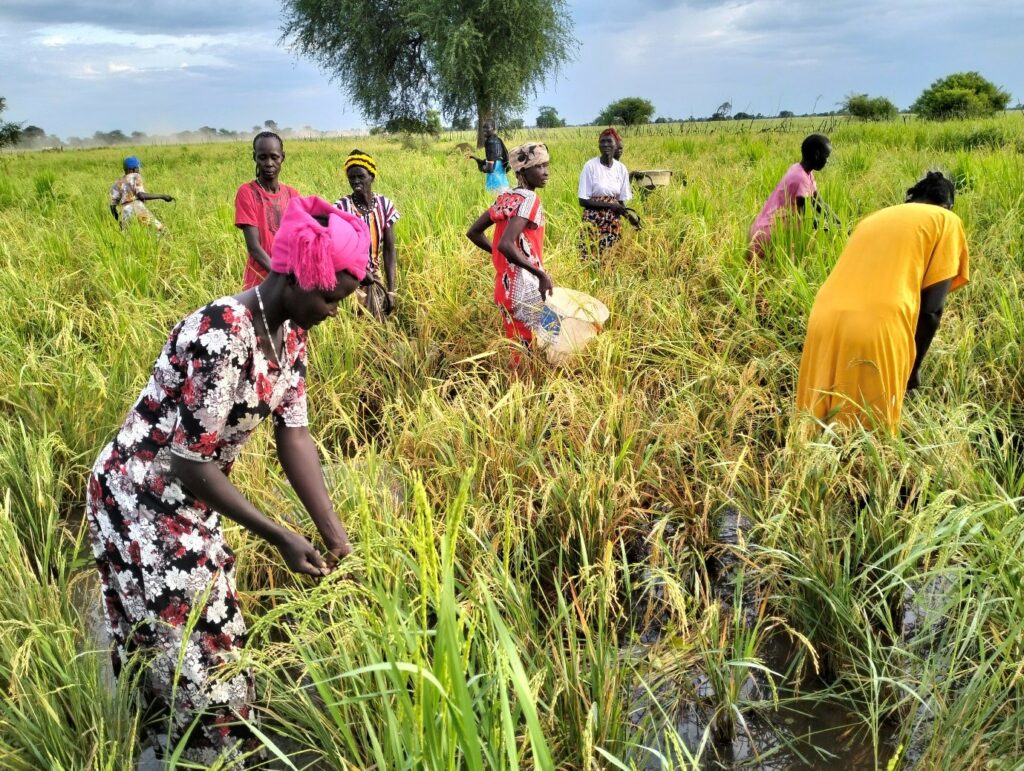
When the rice cultivation was first launched in 2021, there were only very few participants (about 18 farmers).
But in the 2022 planting season, the number of farmers increased to 700 with 691 Feddans (251 Hectares), and more this year, in 25 locations of Warrap state.
In Ajong area of Twic County, some women have adopted the diversification of farming in response to the effects of climate change in the area by cultivating sweet potatoes.
According to the WFP, Warrap communities have been majorly focusing on cultivation of sorghum – a staple crop that has since been the community’s way of life for many years, but which is now vulnerable to climate extremities and cannot withstand both floods and dry spells.
As a result, the agency started building the capacity of the locals by introducing them to varieties of crops.
The crops include rice that flourishes in flooded areas as well as sweet potatoes and cassava on the other hand, that withstand the effects of long dry spells that causes droughts.
Ahok Mathok, one of the beneficiaries of the project, said besides the group farm supported by WFP, they have established their own farms with different food varieties to help their families regardless of floods or droughts.
“Our farm is large, it is five feddans in this area. For this sweet potato, we are planting in ridges, each and every one has her own ridges.”
“Besides these farms, we have individual farms at home whereby we are growing sorghum, we are growing vegetables like okra, tomato, egg plants and beans.”
“During harvest, the bigger portion will be eaten and the smaller one will be sold. With this effort from WFP, we got a lot of trainings, and we are being supported with these seeds, the sweet potato vines.”
“So, after graduation, we will be carrying-on on our own because we have all the required knowledge, we have known how to preserve the vines, we will continue on our own”.
Adut Duot Kiir is another beneficiary of the WFP farming project.
She sponsors her five children’s education and invests in other money-making businesses using the profit she occasionally obtains from the farm produces.
“This project has helped me and with this, I am able to sponsor my children in school and their medication including food. There are times when we get more money and there is time, we don’t get money,” Adut said.
“WFP has trained us and with these skills, I am doing my work, and I can cultivate okra, sell it to get money. I can also make groundnut paste and sell it out, it’s a kind of business.”
On his part, Isaac Amule, the Head of Programs for WFP in Kuajok the initiative to introduce diverse varieties of food crops in the swampy areas of the state, was to fight the impact of climate change.
According to Mule, low production, localized conflict and climatic shocks among others are key drivers of food insecurity in the State.
“As we know, (South Sudan) is experiencing high flooding, we are also experiencing a long spell of dry season happening in this part of the country and as WFP, we realized that these are really the drivers of food insecurity in the country.”
“As an organization, we decided to think of ways of how we can actually mitigate some of these effects of these climates by introducing crops that are resistant either to flood or crops that can do very well in dry places.”
This year under its Assets Creation and Livelihoods, it has ensured the clearance of 22,725 feddans, cultivated and planted with sorghum, groundnuts, green grams, rice and cassava among others.
Besides that, it has also ensured the clearance of 724,781 square meters of land planted with different varieties of vegetables.
This is in comparison to the 2022 farm outcome that saw 30,539 households harvesting 150,465 bags of cereals and groundnuts.
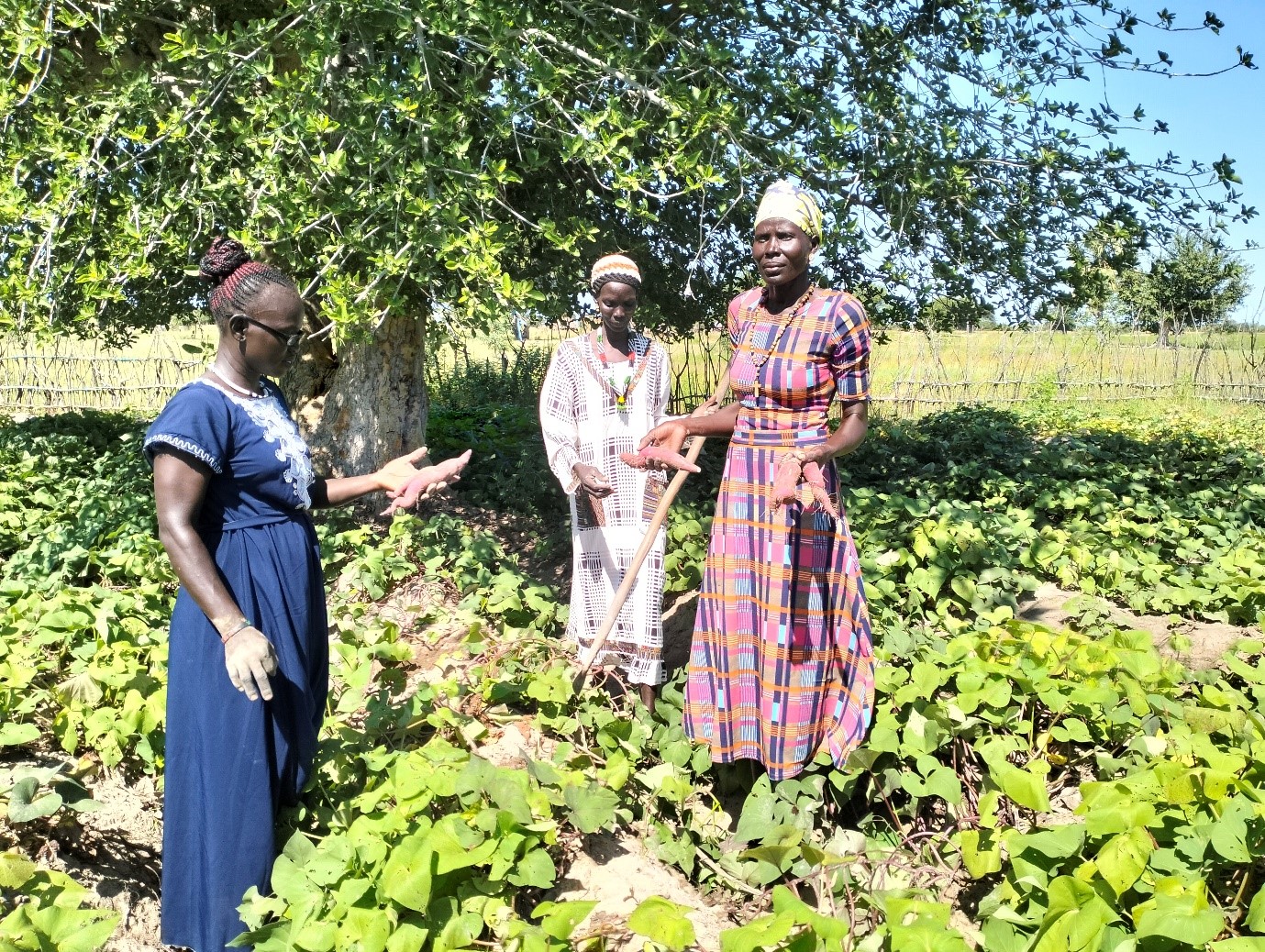
According to WFP, (sweet potato), the drought resistant crop was introduced two years ago.
Like cassava this crop can also have an excellent acceptance by most farmers in the area.
This year about 138 feddans (40 Ha) have been cultivated in 22 locations by 158 participants.
In addition to sweet potato which earns the local farmers good harvest during long dry spells (drought), some farmers in Alek South of Gogrial West County have embarked on the production of cassava.
This was after the World Food Program introduced them the crop and offered them technical skills to help in the cultivation.
Bul Ayom, one of the farmers involved in the cultivation of cassava, said they have been introduced to cassava and offered technical knowledge on the process.
He said this has helped them in pursuing the cultivation of the crop.
“We were introduced to cassava, and we have known how to go about with it. We plant and after planting, we weed. Now we were also taught how to pick the cassava leaves and use it to prepare a meal to be eaten. Now we are good with this.”
Karlo Kuot, Program Quality Officer and the in charge for Assets Creation and Livelihood for WFP based in Kuajok said cassava is a new crop variety in the state.
“This community has been trained to embark on this crop in order for them to resist the further shocks of the climate crisis and that is the drought,” he said.
“Our target is that each and every household should be getting one feddan of cassava so that the two crises as a result of the climate and adaptation during the drought, they will be working on the cassava and other crops like sweet potato.”
Edward Anyuon, Twic County Agriculture Director said the whole idea is to change the mindset of the people.
He said the initiative by the World Food Program to introduce creation of asset was welcomed by the government.
“We want to change the mindset of the people. When the World Food Program came to the area, it implemented the provision of free food.”
“After that, it introduced this project such that the person can create asset and then after he create assets then she/he will be paid according to the policy, and this has been accepted by the ministry. It has helped those who are able to create assets for themselves”.

In addition to the cultivation of sorghum, sweet potatoes, cassava and rice, some women have embarked on vegetable gardening to improve nutrition in their household and enhance their economic strength.
Some households however depend on sorghum and buy vegetables from the market but on accession they don’t have money to buy vegetables, they eat the sorghum posho alone.
Akuon Rebecca is also one of the women who have joined a group of farmers cultivating vegetables.
Akuon previously had one of her children malnourished as a result of insufficient nutrition for her children.
But ever since she joined the vegetable garden group of women, she has been able to use the vegetable produce to feed her children and sell some, use the money to buy what she doesn’t produce at the garden.
Since she started enjoying the garden produce, Akuon’s child started improving and is quite good now in terms of nutrition.
“We are cultivating different types of vegetables as you can see, eggplant is there, tomato is also there and other green vegetables. Last year, we were using crop farming that is sorghum and this year, we started the fence in February,” she said.
“Up to March, we were doing flowering of these gardens and also erecting up the fence and when reached around May to June, that was the time rain started, then we started the production of these crops.”
“I am having children. The one who is the second to the last and the last born. The two were malnourished, they were supported also by WFP nutrition program and before participating in this, that was the time they were malnourished but now their situation has improved, so, they are okay now.”
“The condition that made them malnourished that time, my main economic activity was depending on the charcoal production, and you know the money which I used to get from the charcoal production is not enough to buy this vegetable produce from the market so, by then it was very difficult for me to do that and that was the time that these children were malnourished.”
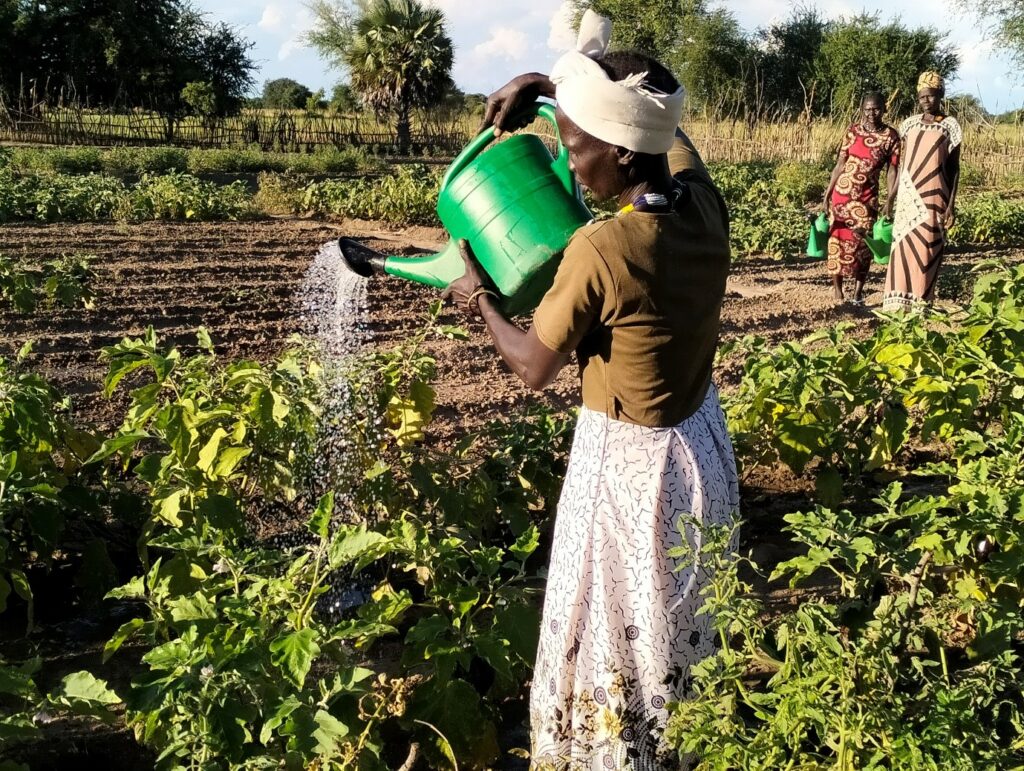
The dyke made from local materials with technical skills and cement from WFP, is now helping the locals of Malual Bul village access Alek Center.
The dyke is about 1.75KM even though it has an extension to the total of 6KM and it’s encouraging many children access learning from the other ends.
However, the WFP says, a 36 km of flood control dyke under construction in 12 Bomas will protect more than 4,550 Feddans of crop farms and villages from flood damage.
While the 27 km of road dyke is connecting different facilities that are inaccessible during rainy season.
The UN food agency has also supported the excavation of a 3 meters multipurpose pond in Alek, Gogrial West County.
More than 500 beneficiaries are expected to benefit from the 3km deep pond with 3,000m3 of water meant for livestock and irrigation purposes during the dry season.
Thiep Thiep is one of the beneficiaries of the pond.
According to Thiep, they used to take their cattle to the neighboring community to access water he says, has often led to conflicts as a result of wrangles over available water.
He now believes that the pond will have reduced chances of taking their animals far in search for water.
Thiep says, the pond is also encouraging the locals in the area to mold bricks, a practice he says was not in existing before WFP’s initiative.
“This multipurpose pond is benefiting the community of Alek. This multipurpose pond helps the community of Alek to provide water for animals and also, they use this water for vegetable production.”
“Not only that, but they are also molding bricks at the dry season, there are some places where there is water at the dry season.”
“They used to take the animals to those places, but it creates conflict in those areas, so, instead they have used this one now for their own, they are not moving the animals to very far places. They were not molding the bricks but now they have it”.
On his part, Isaac Amule, WFP’s Acting Head of Programs said the idea to introduce the water pond was to help the communities preserve water for dry season for their animals and for the irrigation of their vegetables.
“The multipurpose pond is one of the assets that WFP creates through the livelihood program. So, the purpose of this multipurpose pond is to ensure that we have water for irrigating crops during the dry season and also for livestock.”
“As you are aware this part of the country experiences a long period of drought for instance from November to May, so, literally this place runs out of water. So, livestock and even doing small activities like vegetable garden becomes very difficult within that period of time.”
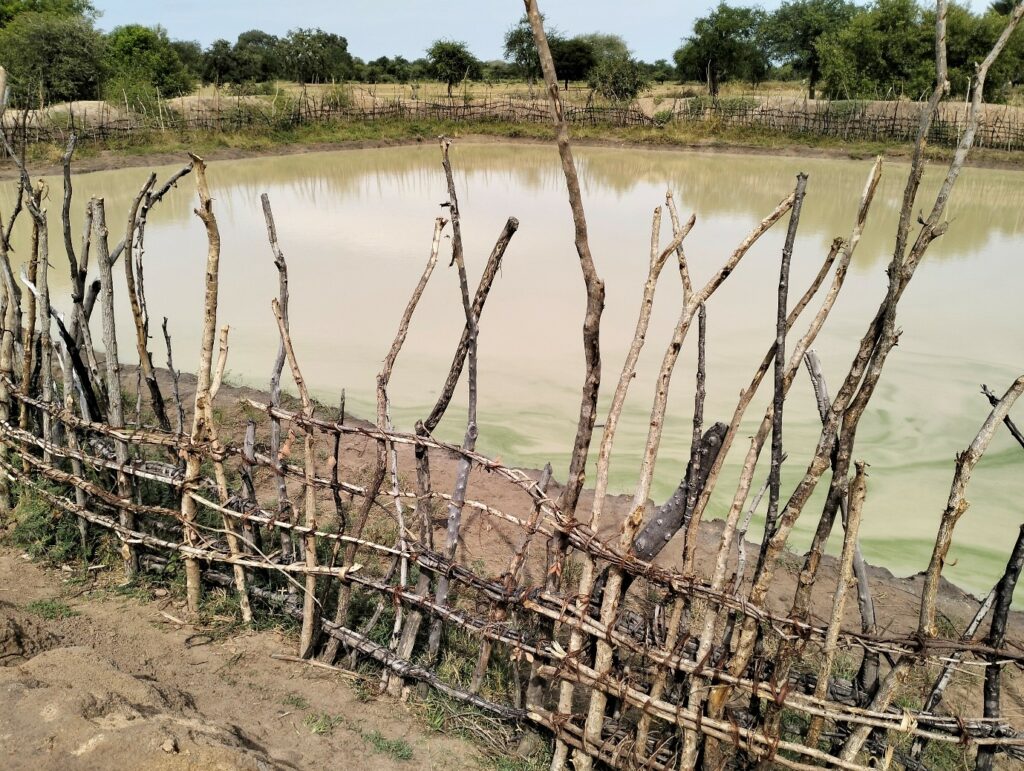
According to the World Food Program, 22,725 feddans (92%) have been cleared, cultivated planted with sorghum, groundnut, green grams, rice, and cassava, among others.
It also says, 724,781 square meters (93%) of vegetable gardens cleared and planted with different varieties and that, 17 KMs (79 %) of community access road were constructed.
The UN Food Agency also says, 103 (75%) shallow wells constructed.
9 (56%) multipurpose water ponds constructed with 339,946 (56%) seedlings raised, planted or sold for income.
It further stated that, 36.78 (68%) KMs of flood control dyke constructed and 27.1 KMs (85%) of road dyke constructed.
Support Eye Radio, the first independent radio broadcaster of news, information & entertainment in South Sudan.
Make a monthly or a one off contribution.
Copyright 2024. All rights reserved. Eye Radio is a product of Eye Media Limited.